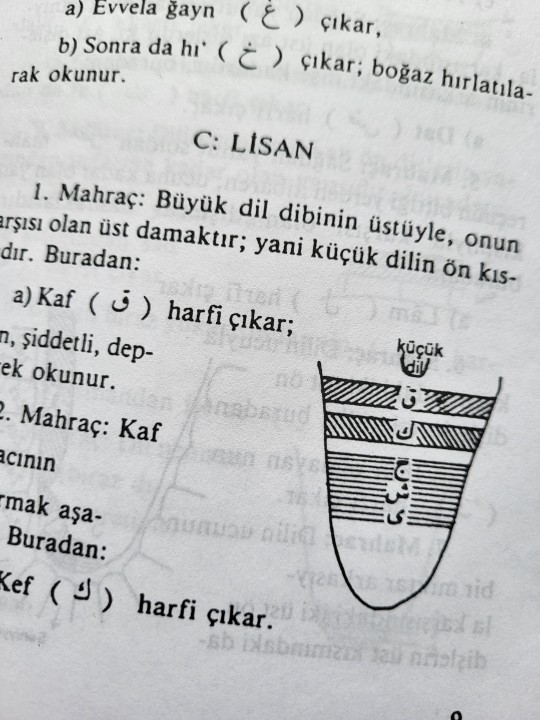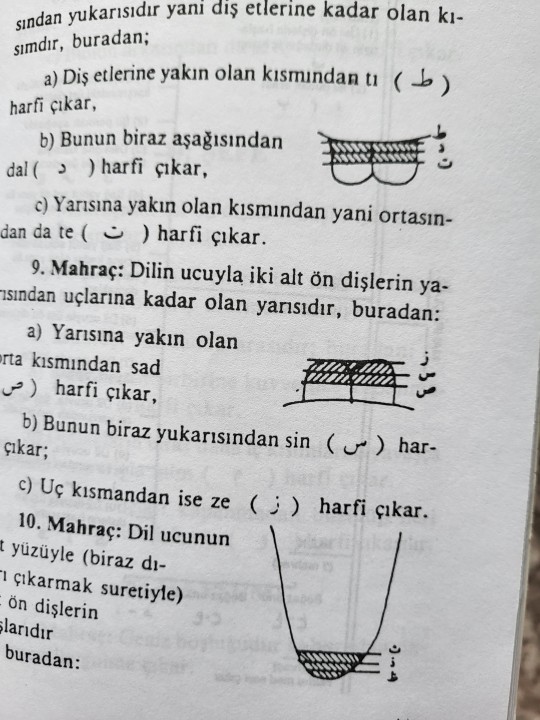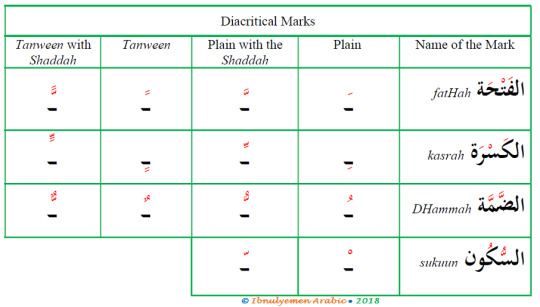#tajweed
Text






illustrations from a booklet on tajweed, written in turkish, published in 1993
#found among my parents' books 🥰#thought these illustrations were endearing so wanted to share them#a min#islam#quran#tajweed#for my non muslims/arabic speakers: tajweed are a set of rules for the recitation of the quran#as it's not to be recited like any other arabic text - but each letter has to be recited perfectly
3 notes
·
View notes
Text
How do you pronounce Allah correctly?
The word Allah (الله) is a special word in many ways. Especially the pronunciation can be tricky if you don't know the rules. Here is how it works.
https://arabic-for-nerds.com/islam/pronunciation-allah/?feed_id=4906
#ISLAM#ARABICLETTERS#ARABICSCRIPT#BASMALA#CONSONANT#EMPHASIS#RAQQA#SHADDA#SHIA#SHIAISLAM#TAJWEED#WIEDERHOLEN#تجويد
2 notes
·
View notes
Text


REGISTER FOR FREE HERE!
1 note
·
View note
Link
If you want to properly learn Tilawa listen to Sheikh El Husary.
4 notes
·
View notes
Text
How can I learn Quran online for free?
Learning the Quran can be a challenging task, especially if you’re trying to do it on your own. However, with the advent of technology, it has become easier than ever to learn the Quran online for free. Here are a few ways you can take advantage of the internet to learn the Quran without spending any money.
Online Quran Courses: There are many websites that offer free online Quran courses. These…
View On WordPress
#community Quran#free Quran#Hifz#Islamic education#online Quran#Quran#Quran apps#Quran courses#Quran learning#Quran tutors#Quranic studies#recitation#Tajweed#YouQaria#YouTube Quran
2 notes
·
View notes
Text
Quran
#Coran#Quran#Recitation#Tilawah#Tajweed#Qirat#Muslim#Islam#Verses#Ayahs#DivineBook#HolyScripture#Spiritual#Faith#Guidance#IslamicTeachings#ProphetMuhammad#MuslimCommunity#IslamicKnowledge#DivineRevelation#DivineGuidance#DivineWisdom#IslamicLifestyle#QuranicVerses#DivineMessage#Inspiration#Reflection#Understanding#IslamicPractices#IslamicValues
0 notes
Text
What Is Madd In Tajweed, Its Types And Common Differences?

Madd, meaning "extension" or "prolongation" in Arabic, refers to the lengthening of specific vowel sounds in the recitation of the Quran. It plays a crucial role in Tajweed, ensuring the correct pronunciation and preservation of the Quran's meaning and beauty.
Here's a detailed breakdown of Madd in Tajweed:
1. The Letters of Madd:
There are three letters associated with Madd, known as Huruf al-Madd:
Alif (ا)
Waw (و)
Ya (ي)
These letters must be silent (without a vowel sound) and preceded by a vowel sign (Fatha, Damma, or Kasra) depending on the letter:
Alif: Preceded by Fatha (e.g., غَافِرٌ - Ghafoor)
Waw: Preceded by Damma (e.g., وَالضُّحَى - Ad-Duhaa)
Ya: Preceded by Kasra (e.g., رَحِيمٌ - Raheem)
2. Types of Madd:
There are seven main types of Madd, each with specific rules and varying lengths of extension:
Madd Asli (Natural Madd): This is the inherent lengthening of the Madd letter due to its nature. It extends for two counts.
Madd Far'i (Branching Madd): This lengthening occurs when a Madd letter is followed by a hamza (ء) without a vowel sign. It extends for two counts.
Madd Wajib (Obligatory Madd): This occurs when a Madd letter sits at the end of a word and is followed by a pause (Waqf). It extends for two to six counts depending on the recitation style.
Madd Jaiz (Permissible Madd): This allows for the lengthening of a Madd letter even when it's not followed by a pause, but only in specific contexts. It extends for one to four counts.
Madd Muttasil (Connected Madd): This type of Madd occurs when a Madd letter is followed by another Madd letter within the same word. The first Madd is slightly extended for one count.
Madd al-Lin (Madd of Ease): This is a subtle lengthening applied to a Madd letter at the end of a word followed by a Sukun (no vowel sign) and then another letter with a vowel. It extends for less than one count.
Madd Aridh Li-s-Sukun (Madd due to Sukun): This lengthening occurs when a Madd letter has a Sukun and is followed by a word that begins with a consonant. It extends for one to two counts.
Intrigued to learn more about Madd and elevate your Quranic recitation? Dive deeper into our comprehensive guide on Madd in Tajweed, exclusively on Alustadh Academy. This in-depth exploration will equip you with the knowledge and practical guidance to master this essential Tajweed skill.
You can learn more and get benefits with us:
Quran memorization course
Quran tafseer course
Best online tajweed course
Advanced Arabic course
0 notes
Text

Noorani Qaida is a fundamental Arabic alphabet learning guide that lays the foundation for reading the Holy Quran with proper pronunciation (Tajweed). It includes essential lessons on Arabic letters, their sounds, connecting letters, and basic Quranic words.
To enroll in our Online Noorani Qaida classes, simply send us a direct message with your name, contact details, and preferred class timings. Our team will get back to you with further instructions and payment details.
#equranforyou#online quran academy#online quran learning#tajweed#online Quran#Quran#Noorani Qaida#USA#Canada#Quran Learning#Qaria#Learn Online Quran
0 notes
Text

Premium BuyDelicious Indian Tea Online | TeaBox
1 note
·
View note
Text
How To Revise Quran Hifz?

Revising Quran Hifz (memorization) is an important part of maintaining the Quran that has been memorized. Here are some tips for revising How To Revise Quran Hifz?:
Set a schedule: Set a regular schedule for revising Quran Hifz. This can be daily, weekly, or monthly depending on your needs and goals.
Start with a quick review: Start each revision session with a quick review of the previous verses or chapters that you have memorized. This will help to refresh your memory and ensure that you haven't forgotten anything.
Recite out loud: When revising Quran Hifz, it is important to recite out loud. This will help to reinforce your memory and improve your recitation skills.
Focus on difficult parts: Identify the parts of the Quran that are more difficult for you to memorize and focus on them during your revision sessions. Spend extra time on these parts until you are able to recite them confidently.
Practice with a partner: Find a study partner who is also memorizing the Quran and practice reciting together. This can help to improve your recitation skills and provide motivation and support.
Listen to recordings: Listening to Quranic recitations can also help with revising Quran Hifz. Listen to recordings of Quranic recitations while following along with the text to reinforce your memory.
0 notes
Text
20 questions for: Habib Kassem (#15)
Episode #15 of my series "9273 roots": 20 questions for the man who created a mobile app that can conjugate Arabic verbs flawlessly: Habib Kassem.
https://arabic-for-nerds.com/interviews/9273-roots/20-questions-habib-kassem-15/?feed_id=5181&utm_source=Tumblr&utm_medium=geralddrissner&utm_campaign=FS%20Poster
#9273ROOTS#ANDROID#CONJUGATION#DATABASE#GOOGLEPLAY#GRAMMARBOOKS#HIJAZ#IMPERATIVE#LEBANESECIVILWAR#MOOD#MOUSTAPHAAKKAD#PASSIVE#PROVERB#SEMITICLANGUAGES#TAJWEED#THEHOUR#THEMESSAGE#WIEDERHOLEN#ألف#مجزوم#GERALDDRISSNER
0 notes
Link
Along with the Quran's profound and noble meanings, there is also its sublime language which, if recited correctly, will soften the hearts of its listeners. The reading of the Holy Quran in a leisurely and relaxed way, in order to achieve the meaning of the verses, is to understand and apply the legislation contained therein during the daily life of the Muslim; reading the Holy Quran without taking into account the various rules of tajweed may change the meaning of words as well as a complete verse.
What is Tajweed? The word tajweed comes from the root of the verb Jawada; which literally means to beautify and improve your reading (doing it well). In the context of the recitation of the Holy Quran, Tajweed is a science of studying the correct articulation of letters.
So it is applied when articulating every letter from its articulation point and giving the letter its rights and dues of characteristics. Rights of the letters are its required characteristics that never leave it. The dues of the letters are its presented characteristics that are present in it some of the time, and not present at other times.i.e. the Qalb, Gunah, Maad.
Manners of Reciting (Tajweed) the Holy Quran
Reciting Quran should be in the presence of one's heart, with full understanding and believing that those are the words of Allah, the Exalted - not the words of man. The Muslim should interact with every ayah with its appropriate meaning and understand each message of the Holy Quran with full recognition that it is directed to him especially. In addition to these internal manners of reciting Quran, there is a lot of external manners. Here are some of the most important manners to follow:
Perform wudhu and be sure of the cleanliness of the body, clothes and place. (It is allowed to read Quran from memory without wudhu; while women with the period are not allowed to touch the Holy book).
Sit with the highest respect to the Holy Quran while facing the Qibla.
Start reciting with At-ta'awwuz and Al-Baassmala.
Do not sit on a place higher than the Holy Quran.
It is not allowed to talk while reading Quran, but if there is an important matter you should stop reading and close the book. Then, you could continue your recitation after saying At-ta'awwuz.
One has to give each letter its due so as to clearly and fully pronounce every word, and each letter.
0 notes
Text


March 23, 2024 - Saturday | Ramadan Challenge 13/30
Day 12: Most challenging thing about Ramadan and how do you try to overcome it?
Nowadays it’s actually fasting that’s the challenge. Subhanallah in the past it used to be trying to do all the stuff on my list lol I try to overcome it by keeping myself on a schedule and taking it easy when I’m not feeling well.
Day 13: What aspects of the qur'anic science have you explored:
I absolutely love tafsir. As a writing/literature teacher, analyzing meaning in between the lines is literally the funnest thing for me and that’s what tafsir is. Honestly when I first introduce literary analysis to my students, I tell them we are basically doing tafsir of the books lol
I love qur’an memorization too and I definitely want to focus more on memorization these days. It’s actually so much fun for me and my silly little productivity obsessed self I soooo looove trackable progress and improving and increasing and it’s the best feeling to encounter memorized ayahs in recitation/ a lecture etc
#Alhamdulillah Alhamdulillah that my tajweed is good (because I learned by copying)#because if I had to learn the rules separately now when I’m older 💀 would have been such a struggle#notes#studyblr#studyspo#ramadanchallenge2024
86 notes
·
View notes


